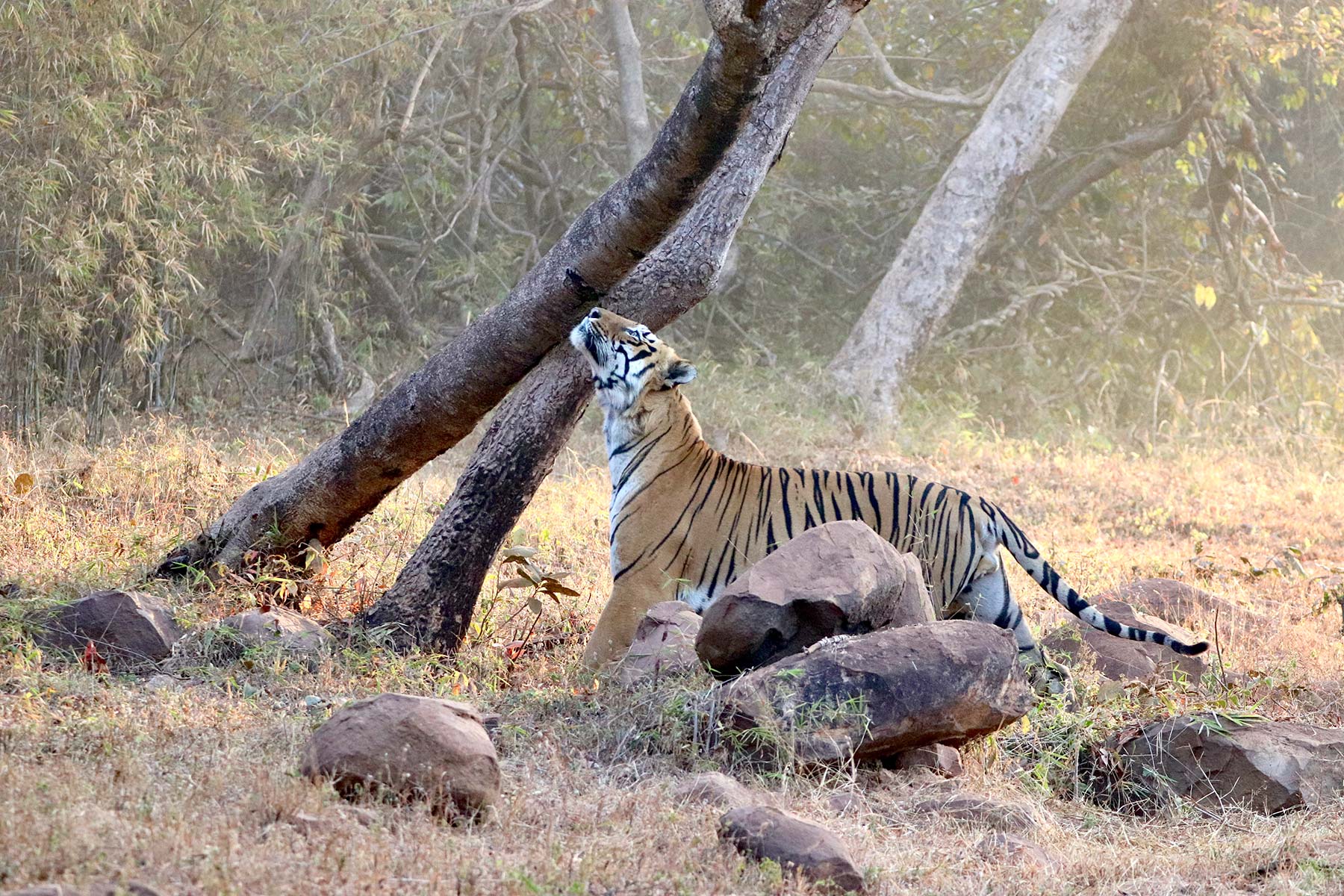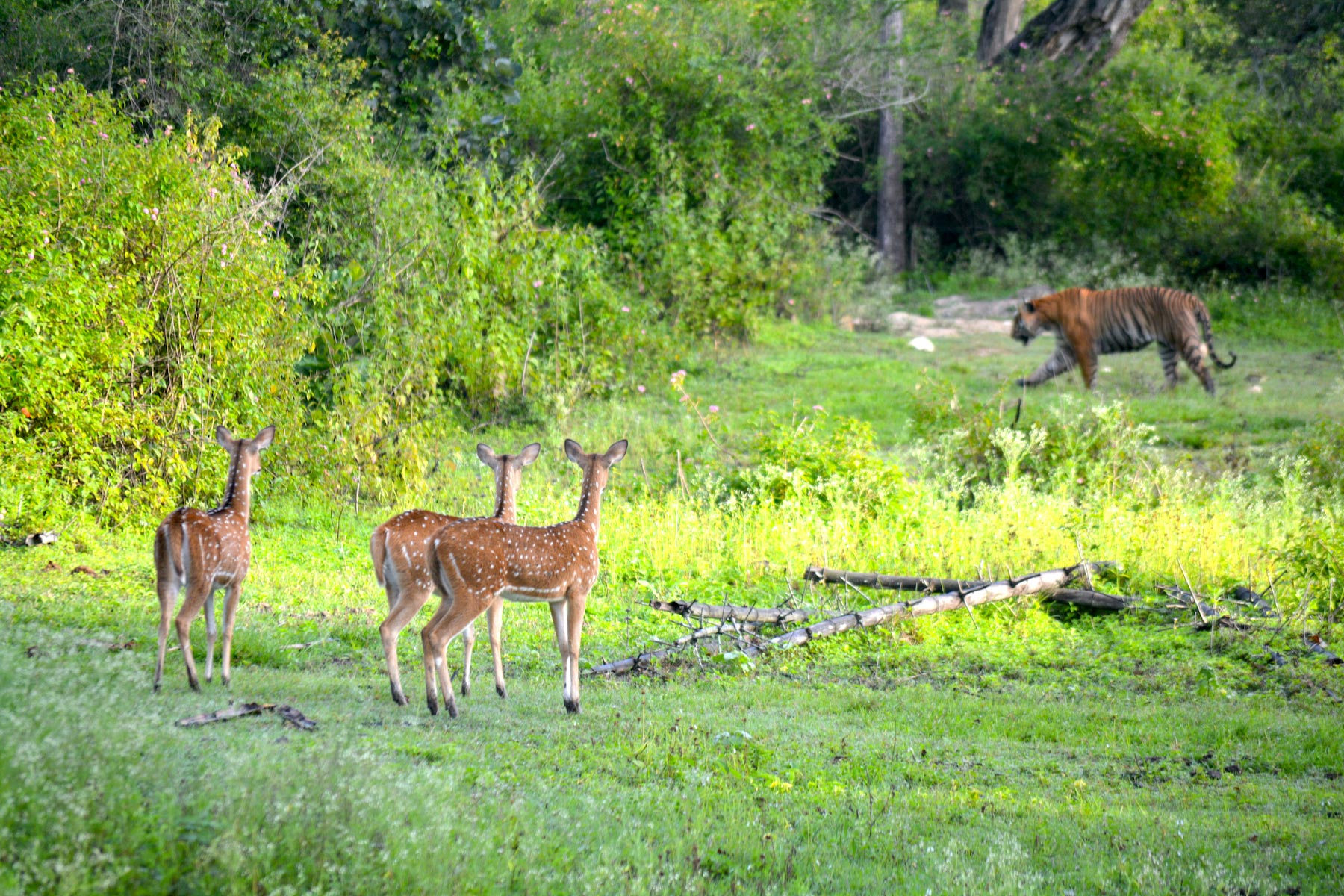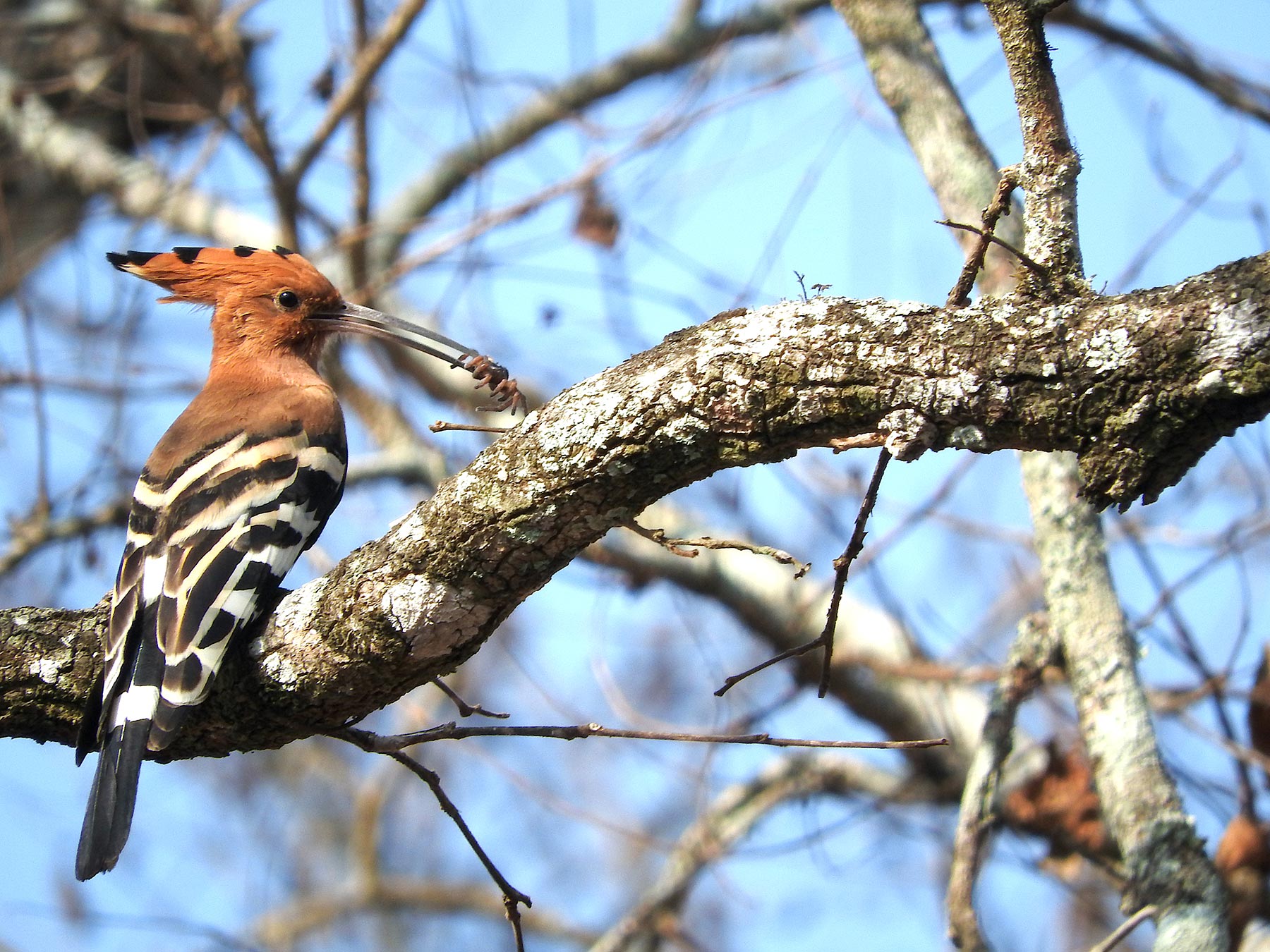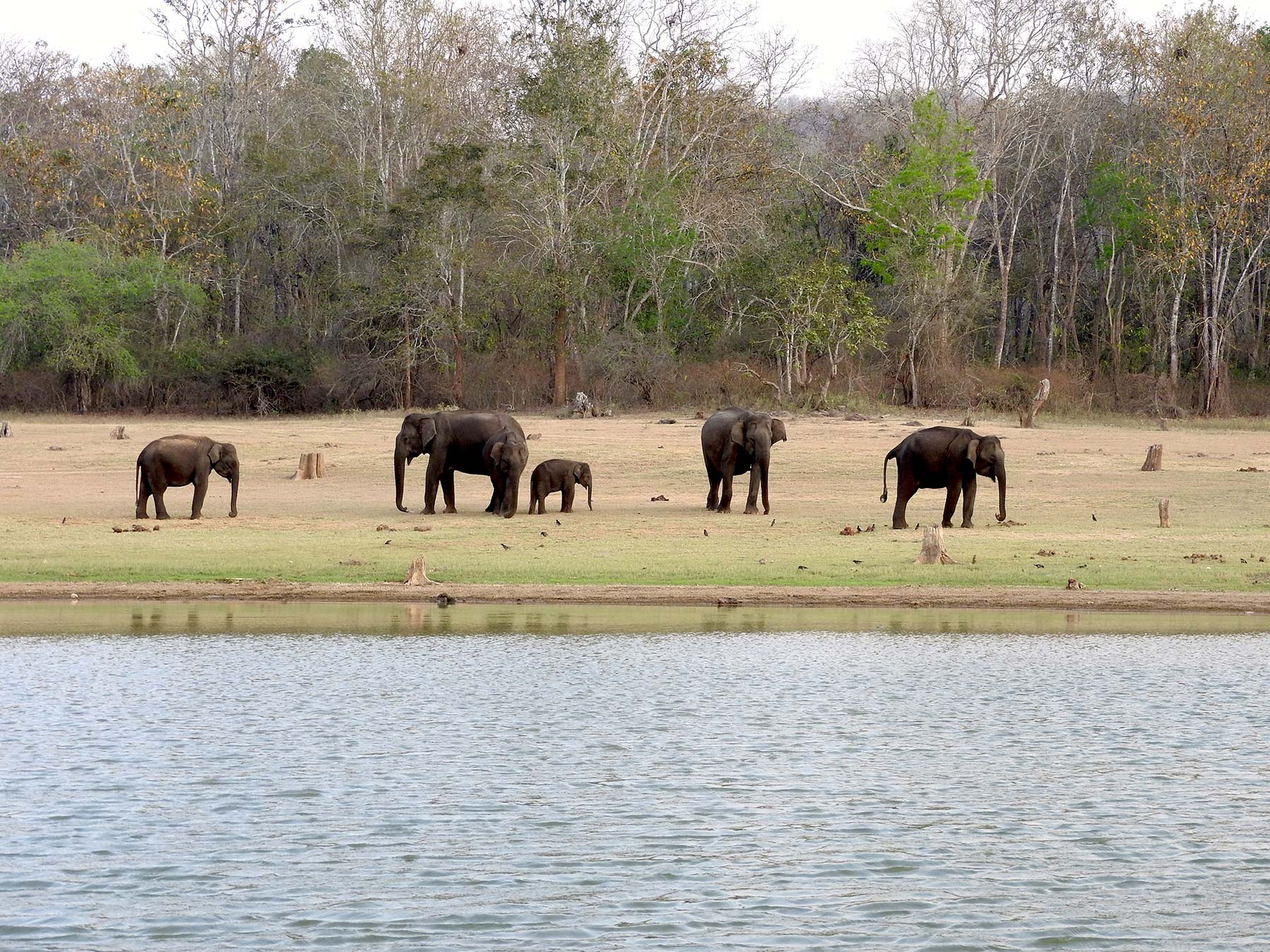It’s an early morning deep in tiger country, at the Bandipur Tiger Reserve in the south Indian state of Karnataka. Cold night gives way to warm day, and the mugginess of the tropics clings to the skin like a hug. This is usually a busy time in the jungle, when the canopy comes alive with birdsong and the brush is twitchy with animal movement. But today the only movement we survey is the bump of our jeep as we hit the trails. That is, until we turn a sharp corner.
Out of nowhere, there he is: a majestic beast pacing just ahead of us on the mud path. Paying no heed to our jeep on his trail, he saunters on, casually spraying urine and clawing on the trees along his way – as one does when one is the jungle’s apex predator. “He’s marking his territory so that other tigers stay away,” explains our guide.
Tiger tracking is a difficult process. Trained wildlife guides and naturalists keep their eyes and ears peeled for signals such as prey alarm calls, fresh pug marks on soil and lingering scents of recent kills. It’s made all the more complex because of how endangered these beasts have become.
In fact, India once came close to completely losing this magnificent species. In the early 1970s, tiger numbers had plummeted to less than 2,000 – from over 40,000 at the time of India’s independence in 1947 – due to unregulated hunting and unchecked poaching.

The resurgence of the endangered tiger
Thankfully, conservation programmes such as Project Tiger – launched in 1973 – have helped boost the tiger population in recent years. Five decades on, India is home to some 53 tiger reserves, such as Corbett in Uttarakhand, Ranthambore in Rajasthan and, of course, Bandipur. The latest tiger census shows that 3,167 tigers, or 75% of the world’s tiger population, can be found in India. As such, it’s the only country that offers tourists a real, viable chance of seeing tigers in the wild.
I freeze, camera midair, heart aflutter, as I look into the gleaming, amber eyes of this king of the jungle.
This is in no small part due to the efforts of zealous government employees who patrol the dense forests day and night – on motorbikes, bicycles and even on foot – to monitor the movement and wellbeing of the local tiger population. They also keep a close watch on unauthorised human activity and ensure that poachers stay away.
I say a silent prayer of thanks to these guardians as our wild companion stops abruptly and turns toward our jeep. I freeze, camera midair, heart aflutter, as I look into the gleaming, amber eyes of this king of the jungle.
Karnataka – home to five tiger reserves and diverse wildlife
When I finally manage to tear my gaze away from his mesmerising black and orange stripes, I catch sight of a herd of deer in the distance. They look up from their grazing, alert and attuned to the tiger’s every move. Within this ecosystem, the tiger is the undisputed king who makes even otherwise fierce leopards hide high up among tree branches.

While Karnataka is where one might find the highest number of tigers in India, several other animals such as chital (spotted deer), gaur (Indian bison), dhole (wild dog), golden jackal, sloth bear and mouse deer also flourish in its five protected tiger reserves.
These five tiger reserves – Bandipur, Bhadra, Nagarahole, Dandeli-Anshi and BRT Tiger Reserves – are in fact contiguous jungles located hundreds of kilometres away from one another. Of these, Bandipur and Nagarahole form part of the UNESCO-listed Nilgiri Biosphere Reserve. Once the hunting grounds for the royal family of Mysore, these forests have since become protected under the conservation programme.

They are among the most significant wildlife habitats in India, hosting the largest elephant population in the country as well as being a birdwatcher’s delight. Over 250 species of birds call these reserves home, including magpie robins, white throated kingfishers, hoopoes, crested serpent eagles, coppersmith barbets, white-bellied drongos and streak-throated woodpeckers.
Sighting elephants in Nagarahole
My hunger for tiger-spotting sated for the time being, I stop for a quick breakfast at the Bandipur Safari Lodge, part of the Jungle Lodges chain, before leaving for Nagarahole. It’s an easy drive through thickly forested roads, with the occasional sighting of chital and gaur. By the afternoon, I’m cruising along the meandering Kabini River on a boat safari.
A large family of tuskers cool off on the river banks. I marvel at their interactions from close quarters: the adults following the lead of the wise matriarch, gently but firmly nudging the playful young ones out of the water when it’s time to move on.

I return home the next day to the crowds and chaos of city life, but there’s a comfort in knowing that the wild surprises of these lush forests are a mere drive away – thanks to the dedication of the conservationists who protect them.
Plan your own tiger-spotting safari
How to get to the tiger reserves and when to visit:
The nearest major airport is Bengaluru, from where both Bandipur and Nagarahole are roughly a five-hour (~250km) drive away. Although these reserves are open through the year, the dry summer months from mid-March to mid-June tend to offer the best chances of tiger sightings.
Where to stay:
In Bandipur, Dhole’s Den is an upscale, eco-friendly homestay, focused on the wildlife experience. The Serai is nestled in a green zone, and offers a more luxurious stay, with a spa and a bar.
In Nagarahole, the plush Evolve Back has a scenic riverside location, while Kaav Safari Lodge offers a chance of glamping amidst wilderness.
Safari tips:
Reserve jeep safaris well in advance through your resort, although it is also possible to book directly online for Bandipur and Nagarahole. In both locations, packages at the government-managed Jungle Lodges Resort include all meals and two jungle safaris each day.
To learn more about Singapore Airlines’ flight service to Bengaluru, visit the official website.
The post Locking gazes with an apex predator in Karnataka’s tiger reserves appeared first on SilverKris.
from SilverKris
No comments:
Post a Comment